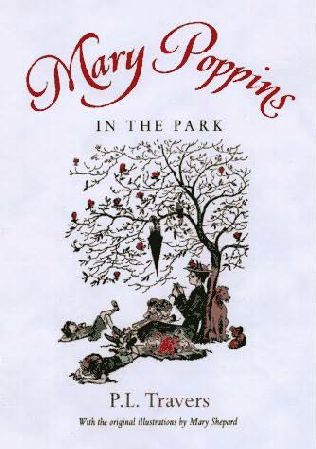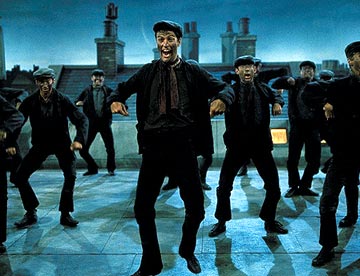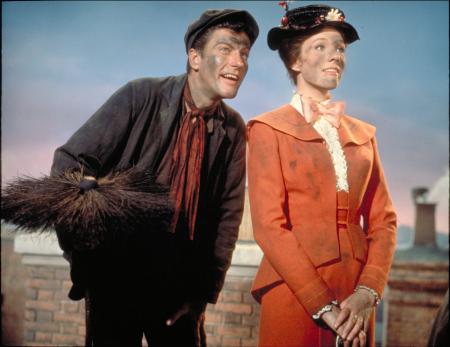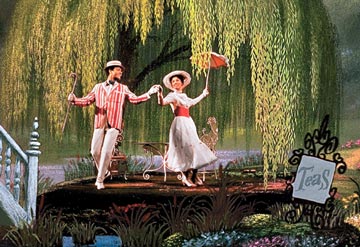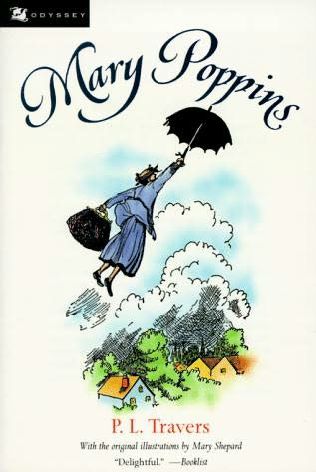Ellen and Jim Have a Blog, Too
We are two part-time academics. Ellen teaches in the English department and Jim in the IT program at George Mason University.


Two Wildly Disparate _Mary Poppinses_ · 22 December 05
My dear Fanny,
One of the assignments I give my students in my Advanced Composition in the Humanities class is called "In search of lost time:" I ask them to find and to reread a favorite book from childhood, try to remember what they felt when they read it then and the circumstances of their lives, and compare these memories with what they feel and see now upon rereading and what they are today.
Philosophically, the assignment is not realistic, as we cannot go back to the past in this pure way. But practically the assignment seems to pose problems only for the growing number of students who have no favorite book. Of the diminishing number of students who were genuine readers as children, one problem is one I’d share: they have trouble deciding which one. Between age 8 and 11 I had three sets of and individual "classic" type books I loved: 1) the Mary Poppins series by P. L. Travers, where my favorite of the then 4 was Mary Poppins in the Park; 2) Louisa May Alcott’s Little Women (which for me included Good Wives); 3) Frances Hodgson Burnett’s The Secret Garden. In the first and last I particularly loved the scenes of the quiet green parks:
I studied the map of the park Mary Shepard drew, and sitting here tonight 51 years later I still remember the general outline of the park, the style of drawing, the colors, and where different places the characters’s adventures happened were located on that map. What a contrast to the south-east Bronx where I lived1.
I was nearly 18 when I heard there was and went to see "a Mary Poppins movie2." I’ve a dim memory of waiting on a long line outside a theatre to see it. I’m not sure—this event comes from the years (17-19) I can’t remember things so I partly reconstruct from what I’ve been told and may have seen the movie at Radio City Music Hall. The trip would’ve been an adventure and treat in itself—I grew up in the suburbs and to me Manhattan was then still a glamorous place. I probably assumed the audience was made up omostly of people who had read the book. According to Caitlin Flanagan, Disney knew better.
I do remember how astonished and at first disappointed I was when I found myself watching a movie utterly disparate from the books I had so loved. The movie had a couple of the opening memorable moments of the books, e.g., Mary Poppins slides up the bannister of a stairwell; she has delightful tasting medicine in her bag. Two episodes were faintly dependent on two episodes in the books: the children and Mary Poppins enter a picture Bert, a sidewalk artist, has chalked into the sidewalk; they visit an uncle of Mary Poppins whose dining table floats near the ceiling. But that was all that was at all close in spirit. I say at first because by the end of the movie I had been charmed: what I remember best about the film now are the fantastical sequences of dance and song, particularly one of the Julie Andrews and Dick Van Dyke dancing up and down magically appearing and disappearing sparkling staircases in the sky high over the roofs of London, from which I take this wildly energetic moment of Dyke leading the other men (as chimney sweeps):
This blog has been prompted by an excellent article by Caitlin Flanagan in last week’s New Yorker (December 19, 2005, pp. 40-46 in the paper edition):
"
Becoming Mary Poppins: P. L. Travers, Walt Disney, and the making of a myth."
Take a moment to read it, dear Fanny. I want to make more emphatic a few insights Flanagan keeps in her margins or only hints at, and add some inferences I suspect she sees and has suppressed, and report about the conversation we had about book and movie on WWTTA.
First, Flanagan dispells the public image of P. L. Travers as spinster and replaces it with a young Australian woman who came from a family torn apart by alcohol and violence where the mother after an open attempt at suicide, lived life apart for herself to survive; Pamela Travers came to London as an ambitious young woman, and very like Dorothy Sayers (who is also in public myth a spinster), Travers had lovers and lived unconventionally. Then Flanagan shows that the original Mary Poppins is an subversive icon for women of the realities of their complicated ambivalent feelings about children and motherhood as well as one for children’s attudes towards their mother, especially their instinctive anxiety (often played upon by parents) that the mother like as not will abandon them if she needs to. One of the most memorable lines in Travers’s Mary Poppins’s repertoire of unanswerable enigmatic cool retorts to the children is: "I’ll stay till the wind changes."
The delight the child reader feels comes from discovering that under the mother substitute’s distance, contradictory stances, an apparent dislike and disdain of you, as well as a willingness to punish, and at moments strange indifference to your safety ad needs is an intensely exciting imagination, tender heart, kindness, and deep courtesy towards others. Mary Poppins demands others respect her privacy and she respects theirs.
Flanagan makes visible the anti-feminist and fatuous recasting of the story by the Disney people so the film’s center becomes a father who learns to make playing with his children the center of his life, with the mother learning her most important calling is not the frivolous business of getting the right to vote, but also playing with her children and adoring her now loving husband. Nothing could be further from the original slant of the plot: in the four novels I read the parents are kept in the margins and at a distance from the children. They want a nanny to discipline the children, and keep them orderly, obedient, in good health—and, very important this, quiet, out of sight.
Flanagan says that Travers saw Disney as someone who "traded in sentimentality and cynicism, two qualities she despised." Travers thought most of the "Disney oeuvre" was "manipulative and false." She recognized that one strain in the folkloric typology Julie Andrews represents are the chracteristics of a "soubrette." This is not quite true as Disney probably sincerely held to a conservative, patriarchal agenda, dominant in the popular culture of American in the 1930s-50s: optimism, avuncular sexless figures, happy endings, and materialism.
In this particular film too the sophisticated artful film-makers took over some of the psychological and social characteristics Andrews had projected in her performance as the hard-working working class free spirit Eliza (from Lerner and Lowe’s adaptation of Shaw’s My Fair Lady), joined them up to a very mild subversion in Dick Van Dyke’s projection of the artist-bohemian free spirit (ever so respectful of the upper classes too), and turned them into a delicately aspiring-gentlewoman and eager, kindly aspiring-gentleman worshipper of her as we see in this moment of hope:
Irony of ironies though: the film has not only replaced the books in the wider public’s perception. It has been turned into a self-flattering icon for the Bushite affluent classes. These (only sometimes careerist) upper middle class mothers apparently exclaim of their underpaid child-care provider: "’She’s the Guatemalan Mary Poppins!’" Flanagan says these remarks show those who utter them have conveniently forgotten (or never noticed) that the film’s moral is "’fire the nanny’ and devote yourself to the children." A film whose content the Disney people feared would be strange to the American public (why should people need a nanny?) is now central to the some of the hypocrisies of the present "nanny" culture of the American upper middle class.
A few of us on WWTTA wrote about our memories of the book and film. I’ve already told you mine. Here is Miss Schuster-Slatt:
"How mesmerizing was that account of that clash of titans, Travers and Disney. How do you connect this Australian oldest child with a suicidal mother, who goes to England and becomes journalist, poet and lesbian—to the person out of whose primordial complexes came: Mary Poppins?"
Kathy responded:
"I read the New Yorker article about Travers and was astonished to learn she’d written eight Mary Poppins books. How many were there in my childhood? Perhaps four or five?
I was disappointed in the movie as a child. Am not surprised that the witty Travers had "issues" with it.
My favorite Travers book was I Go by Sea, I Go by Land, the story of some evacuee children during World War II. I wonder if it’s still in print."
Leslie R was prompted to read the book, and offered her reaction to her reverse situation: when she was young she saw the film:
"I finally read [P. L. Travers’] Mary Poppins a couple of months ago, partly because so many on this list spoke of how important it had been to them as children. How I happened not to have read it as a child I don’t know. I knew the Disney movie was very different, but I was astonished nevertheless at how different the book is, by how hard-edged, astringent, and wholly unsentimental (and therefore unDisney) it is. Knowing the film well, I of course read the book through that lens. Mary herself is transformed in the movie into a jolly cartoon, whereas she is like some ancient goddess in the book, alternately fascinating and terrifying, and the Banks family is unrecognisable."
Mary Shepard’s illustrations bring out another element in the original series erased by the rich luscious and vivid beauty of Disney’s deep zoom shots and elaborately-furnitured, exquisitely-costumed mise-en-scènes, e.g.,
Shepard’s Mary Poppins is a lone and sometimes forlorn figure, someone who apparently has no sex life, a woman who must move hastily, defend her space, is awed by the magical people she takes the children to visit, a sturdy and thrifty but make-shift servant who can turn a travel-bag to uses which include eating on and living under it, and who needs her well-made hard-earned umbrella:
There is a still in the 1996 Emma (Miramax, director, screenplay Douglas MacGrath and ITV/A&E, director Diarmuid Lawrence, screenplay Andrew Davies) where Kate Beckinsale has nightmares in which she loses Mr. Knightley to Jane Fairfax or Harriet. In these she is suddenly pictured as forlorn, downtrodden. In one of these Kate Beckinsale wears a shabby dark coat that recalls Mary Shepard’s illustrations for P. L. Travers’s Mary Poppins.
For me it’s doesn’t matter whether someone prefers Travers’ and Shepard’s Mary Poppins or Disney’s as given life and typology by Dick Van Dyke and Julie Andrews. What is important is to recognize what it is we are allured by in both, the nature of the lies, truths, and pleasures we are offered by both, and finally (not least important in Flanagan’s article) how the world really works. Travers made a career through persistent effective cliquism rooted in her Australian-English connections and by not living a conventional woman’s life; Disney paid her a huge sum (she was given 5 % of the gross of the film, and it made her rich); Disney alternated between lavish courting, fobbing Travers off to fight with underlings who were given no power3, and cutting her dead socially once the movie was made and a success.
Chava
1 Of course I also loved Judy Bolton and Nancy Drew mystery series types of books (see Girls’ Books and Womens’ Lives), to say nothing of my later fascination with lurid magazines with stories with titles like "I was a teenage slut" and "Poor Cow."
2 For two more student essays in this genre, see "A Rediscovery of The Velveteen Rabbit," and "E. B. White and Charlotte’s Web. I have the students read Bobbie Ann Mason’s The Girl Sleuth: On the Trail of Nancy Drew, Judy Bolton, and Cherry Ames, an exercise in this subgenre of memoirs in books.
3 This is what happened to me when I was supposedly given an opportunity to have my translations of Veronica Gambara published: the publisher said I was to wrest the space from another woman who would then just write the introduction and notes. The description of how Disney disappeared and left Travers to talk to powerless people reminded me of how this older male publisher (with a respected scholar’s position in a university) told me to negotiate with a young woman graduate student & teacher who had been promised she was to do the University of Chicago edition of Gambara’s poetry in translation and saw this as her key to tenure. This publisher had not even given her a contract after 2 years of (altogether unsupervised or unwatched I gather) work.
--
Posted by: Ellen
* * *
Comment
- Ellen,
What a lovely piece on Mary Poppins. Admittedly I’d forgotten about her until I read the piece in The New Yorker, but the books fascinated me as a child. I read them over and over, along with E. Nesbit’s fantasies, Rumer Godden’s An Episode of Sparrows, and Frances Hodgson Burnett’s The Secret Garden and A Little Princess. I had a vague notion that if I lived in England, life would be much more fascinating.
As I said on the WWTA list, I was disappointed in the movie. My mother took me to adult movies from the time I was a small child; consequently Disney movies never measured up. I enjoyed the movie on a certain level, but it had very little to do with the book, in my view.
But you even make me want to see the movie again. Dick Van Dyke!
My favorite Travers novel, I Go by Sea, I Go by Land, is out of print. But used copies are available at Amazon, Alibris, etc.
— Kathy Dec 23, 11:31am # - When I was young, my favorite book was Corderoy. Then in 6th grade, The Giver was my favorite book.
In elementary school I loved reading, and then in middle school and high school I did not like reading at all. I tried to convince myself to like reading from 10th grade to my freshman year of college, but I didn’t succeed in making myself like it. Then this summmer I read two books I really liked, The Curious Incident of the Dog in the Nighttime, and the 5th Harry Potter, and now I like reading. I read a book this week, and I finished it about an hour ago. I loved it. It’s called My Sister’s Keeper. I think you should read it; my guess is that you’ll like it. I really want to read more books now, so my love of reading has come back. I don’t know why I liked reading in elementary school and then stopped liking it, and now I’m back to liking it.
— Jennica Dec 23, 3:25pm # - Jennica,
Just wanted to say that I also read The Curious Incident of the Dog in the Nighttime and to recommend another unusual novel about autism, The Speed of Dark by Elizabeth Moon. It’s very good and won a science fiction award. Although it’s set in the future, it doesn’t really read like SF.
When I was in college, I also loved The Golden Notebook by Doris Lessing and anything by Dickens.
Glad to hear you’re enjoying reading again.
— Kathy Dec 23, 6:03pm # - Dear Jennica and Kathy,
I too had a period where I didn’t read. Around age 14-15 I stopped for a while. My guess is my mind was too troubled. But I picked it up again and haven’t stopped since :).
In the fifth grade I was still reading Nancy Drew and Judy Bolton books. It was in the 6th I began to make a transition to books for young adults and adults.
My Sister’s Keeper looks very interesting. Since I became an English major pretty quickly, I was reading a lot of books in college. One I loved was Ann Radcliffe’s Romance of the Forest.
I read The Golden Notebook in graduate school. Oh it was an eye-opener and exhilarating. I still have my old copy.
Thank you both so much for your comments. I hope you’re both having a happy evening. Tonight I finished a novel I’ve loved: Margaret Oliphant’s Kirsteen.
Jennica, have you ever tried 19th century novels? I really recomend Elizabeth Gaskell’s Mary Barton or Wives and Daughters. Izzy liked Wives and Daughters. There’s a wonderful film adaptation
too.
Chava
— Chava Dec 23, 11:14pm #
commenting closed for this article

